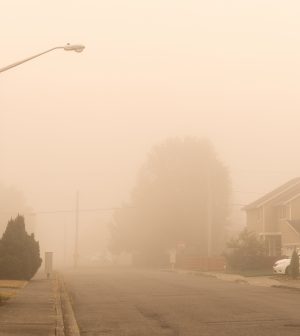- See What Saffron Can Do for Sleep and Heart Health
- 6 Common Mistakes to Avoid Before Your Physical
- Can Sweating Really Help You Beat a Cold?
- Strengthening Your Relationship: Practical Strategies
- Skip Storing This Everyday Product in the Fridge Door
- Green Tea + B3 Pairing May Boost Brain Health
- Navigating Your Midlife Crisis: Embracing New Possibilities
- City Raccoons Showing Signs of Domestication
- Mapping the Exposome: Science Broadens Focus to Environmental Disease Triggers
- One Week Less on Social Media Linked to Better Mental Health
Wildfire Smoke Could Cause More Than 9,000 U.S. Deaths Each Year

Clouds of smoke continue to drift over the Eastern United States and Europe from wildfires in Canada, and experts are predicting a longer and more destructive wildfire season due to rising temperatures and drier conditions.
Now, new research puts a number on just how dangerous wildfire smoke can be.
Smoke particulates from wildfires could cause 4,000 to 9,200 premature deaths and may cost between $36 billion and $82 billion each year in the United States, according to the new study.
Wildfires release fine particulate matter, or PM2.5, into the air, and these very tiny particles can travel deep into the lungs and bloodstream and trigger an asthma attack, heart attack or strokes, among other risks.
Symptoms may include coughing, wheezing and feeling short of breath. Wildfire smoke can also make conditions like asthma and bronchitis worse, said study author Yunsoo Choi, an associate professor of atmospheric chemistry at the University of Houston.
“PM2.5 from wildfires can also have effects on the heart and blood vessels, increasing the chances of heart attacks and strokes, and making existing heart conditions worse,” he said. “It can cause general inflammation in the body and trigger allergies.”
Certain groups, such as children, older adults, pregnant women and individuals with existing respiratory or heart problems, are more vulnerable to PM2.5 from wildfires, Choi said.
For the study the researchers, led by Oliver Gao, a professor of civil and environmental engineering at Cornell University, developed a model to estimate how smoke from wildfires could impact human health and economies using satellite wildfire emission and air quality data from 2012 to 2014.
They found that California, Florida, Texas, Georgia, Alabama and North Carolina are likely to have the highest number of premature deaths due to the volume of particulate matter distributed by the smoke. Cities located near fires, such as Los Angeles, Houston and Atlanta, will also likely see a spike in early death and corresponding economic losses, the study determined.
In the model, New York City would experience 86 premature deaths resulting from wildfires and would see $780 million in associated economic costs.
The authors point out that these may be underestimates as changing patterns of temperature could drive the number of wildfire-related premature deaths even higher.
Laws and regulations including planned forest thinning could reduce the harmful effects of wildfires.
“In this era of climate change, if we remove flammable vegetation and do things like create green fire breaks and reduce the fuel for the fires, we can substantially decrease the harm of smoke downwind in populated areas,” Gao said in a Cornell news release. Green fire breaks involve planting strips of low-flammability vegetation in strategic areas.
The study was published in the June issue of the journal Science of the Total Environment.
Dr. Neil Schachter is a professor of pulmonary and community medicine and medical director of pulmonary rehabilitation at Mount Sinai Medical Center in New York City. He reviewed the findings and called this an important study.
“We have long been aware that high levels of PM2.5 particulates that are routinely found in air pollution can cause an increase in health issues, but here we have a large-scale study that puts actual numbers to our concerns,” Schachter said, adding that more research is needed to better understand the health effects of wildfire smoke.
“This study did not provide data on the increased incidence of health issues in particular, cardiovascular events, chronic obstructive pulmonary disease [COPD] exacerbations, asthmatic attacks, pregnancy, and the health of fetuses,” he said.
Dr. Panagis Galiatsatos is a volunteer medical spokesman for the American Lung Association a pulmonary and a critical care medicine physician at Johns Hopkins Medicine in Baltimore. He also reviewed the findings.
“Mother Nature will continue to do what she does, and we can’t control Mother Nature, but we shouldn’t be our own worst enemies by creating more man-made pollution,” he said.
Much can be done to reduce man-made pollution, Galiatsatos said. This includes the push for zero-emission electric vehicles that don’t emit pollutants into the atmosphere.
It’s also important to boost efforts to improve indoor air quality, he added.
“If we tell people not to go outside because outdoor air is unsafe yet indoor air quality is just as bad if not worse, it’s an issue,” Galiatsatos said. “It’s time to make sure that indoor air quality is held to an appropriate standard.”
This calls for making sure the home is a smoke-free zone, testing for radon and keeping humidity levels under 50%.
More information
The American Lung Association has more about the health effects of wildfire smoke.
SOURCES: Yunsoo Choi, PhD, associate professor, atmospheric chemistry, AI deep learning (machine learning), air quality modeling, satellite remote sensing, University of Houston; Neil Schachter, MD, professor, pulmonary and community medicine, and medical director, pulmonary rehabilitation, Mount Sinai Medical Center, New York City; Panagis Galiatsatos, MD, MHS, volunteer medical spokesman, American Lung Association, pulmonary and critical care medicine physician, Johns Hopkins Medicine, Baltimore; Cornell University, news release, June 21, 2023; Science of the Total Environment, June 2023
Source: HealthDay
Copyright © 2025 HealthDay. All rights reserved.










